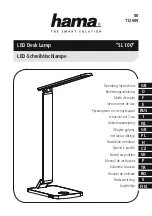
RDM Explained
GenVI Dimmer
Operator Manual V1.0
Page 26
6
RDM Explained
6.1
OVERVIEW
RDM stands for Remote Device Management. It is an “extension” to DMX.
Since the inception of DMX it has always been a ‘one way' control system. Data only ever
flows in one direction, from the lighting controller outwards to whatever it may be connected
to. The controller has no idea what it is connected to, or even if what it's connected to is
working, switched on, or even there at all!
RDM changes all that allowing the equipment to answer back!
An RDM enabled moving light, for example, can tell you many useful things about its operation
- the DMX address it is set to, the operating mode it is in, whether its pan or tilt is inverted
and how many hours since the lamp was last changed.
But RDM can do more than that. It isn't limited to just reporting back, it can change things
as well. As its name suggests, it can remotely manage your device.
RDM has been designed to work with existing DMX systems. It does this by interleaving its
messages with the regular DMX signal over the same wires. There is no need to change any
of your cables but because RDM messages now go in two directions, any in-line DMX
processing you have needs to be changed for new RDM hardware. This will most commonly
mean that DMX splitters and buffers will need to be upgraded to RDM capable devices.
To utilise RDM you will also need an RDM controller. Presently these are devices that plug in
to the DMX line and talk the RDM language. They put the messages on to the DMX line, listen
for any replies and display the results via an attached computer. The latest lighting consoles
now also come with RDM controllers built in.
RDM also has the ability to read and report operating statistics and error conditions from any
enabled equipment that supports it. This opens up the possibility of remotely monitoring the
condition of your lighting rig and getting notice of failed equipment or even advanced notice
of things that may be cause for concern. For example, a moving light that reports a very high
bulkhead temperature may be suffering from a failed fan or clogged filter or a scroller that
reports a high motor current may have a jammed scroll.
6.2
GENVI RDM
LSC’s GenVI Dimmer range are RDM enabled products. This allows you to use RDM to
interrogate the dimmer to find out its status such as:
Temperature.
Fan Speed.
Presence of input power phases 1-3.
The GenVI will also send out an over temperature alarm when the temperature
reaches 90 Celsius.
Содержание Gen VI
Страница 4: ......





































